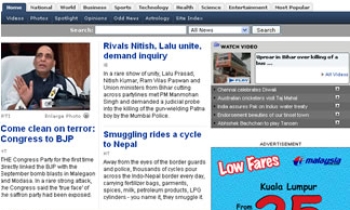Newspapers must refocus all their energies on revenue growth and circulation growth if they are to reverse perceptions that are clouding the industry's future, according to a new report titled "Newspaper Outlook 2006: Managing Perceptions." Such a focus would be a departure from the newspaper industry's current defensive posture that is producing lost market share for readers and advertisers.
The "Newspaper Outlook 2006" report represents the fifth annual strategic examination of the newspaper industry by the International Newspaper Marketing Association (INMA). INMA is a non-profit association dedicated to promoting advanced marketing principles within the newspaper industry, and is based in Dallas, Texas, US.
The report has been authjored by Earl J Wilkinson, executive director of INMA. Wilkinson, who authored four previous "Newspaper Outlook" reports for the newspaper industry in 2001, 2002, 2003, and 2004, also writes a monthly column at INMA.org on trends and developments in newspaper publishing. Newspaper Outlook 2006 says where newspapers are today, and where they are likely to go in 2006-2010.
The report says varying circulation and readership fortunes for newspapers will depend more on market conditions than practices employed. Advertising will increase for newspapers, yet below economic growth and general advertising growth. Newspaper profitability will not rise until newspaper managements settle on the models to enhance revenue.
The "age of experimentation" will continue with free newspapers, "lite" newspapers, websites, and mobile text messaging becoming standard parts of the newspaper industry. The strategic issue for newspapers is not where they are today or where they are going in the future; newspapers are clearly moving from a mono-media present toward a multi-media future. Instead, Wilkinson says, the issue is what specific form the transition to multi-media will look like. Managing the transition, he predicts, will involve the confrontation of many perceptions about newspapers – both good and bad.
The report suggests that newspaper managements must consider customer perceptions in their decisionmaking processes. Since the market has repositioned newspapers from a "need" to a "want," Wilkinson argues that focusing on the emotional characteristics of what readers and advertisers want will yield better circulation and advertising results than the more traditional rational communications approach.
The INMA report feels false perceptions give newspapers the opportunity to engage customers through marketing and public relations, while true perceptions should prompt them to consider more tangible changes. It says that the product focus thus far has not worked for newspapers.

Wilkinson talks of stark choices that would face newspapers. INMA analysis of US government data shows that newspapers have done a rather tepid job of increasing revenue during the past decade. As managements realise they are operating outside of the traditional boom-and-bust economic cycles, they are confronted with the need to reduce expenses – and reinvest in areas likely to grow future revenue.
Despite market challenges, newspapers continue to invest only a small amount of revenue in marketing themselves. With newsprint prices expected to rise again in 2006 and inflation-adjusted newsprint prices remaining low, these "below the line" expectations leave newspapers with stark choices: they can lower profit expectations, cut costs and boost profitability, or cut costs and reinvest in revenue-generating areas.
Wilkinson looks at circulation and readership performances of newspapers, and observes that young adults faced with a market where information is everywhere are changing their consumption habits toward multimedia and multi-tasking while consuming media. So what should be done? He says newspapers must shift toward attracting the "random access reader" if they are to keep up with these trends.
The good news is that most newspapers have an influential readership base from which to build; the bad news is that there is a cultural tension within newspapers about whether to focus on a general mass market or this influential niche market.
Newspaper advertising growth in 2006 is expected to be far below economic growth and general advertising growth projections. This is true worldwide, says Wilkinson, except for China, India, and parts of Latin America. Unfortunately, he rues, newspapers are at the wrong end of broad trends impacting advertising: Technology-driven audience fragmentation, advertising clutter, the advertiser’s new obsession with return-on-investment for marketing expenditures, and a technology-empowered consumer able to block out marketing messages. Newspapers, however, are fighting back against these advertising trends through national efforts that attempt to change the perception of newspapers by advertisers, advertising agencies, and media buyers.
[To purchase the report, please visit the INMA website.]










